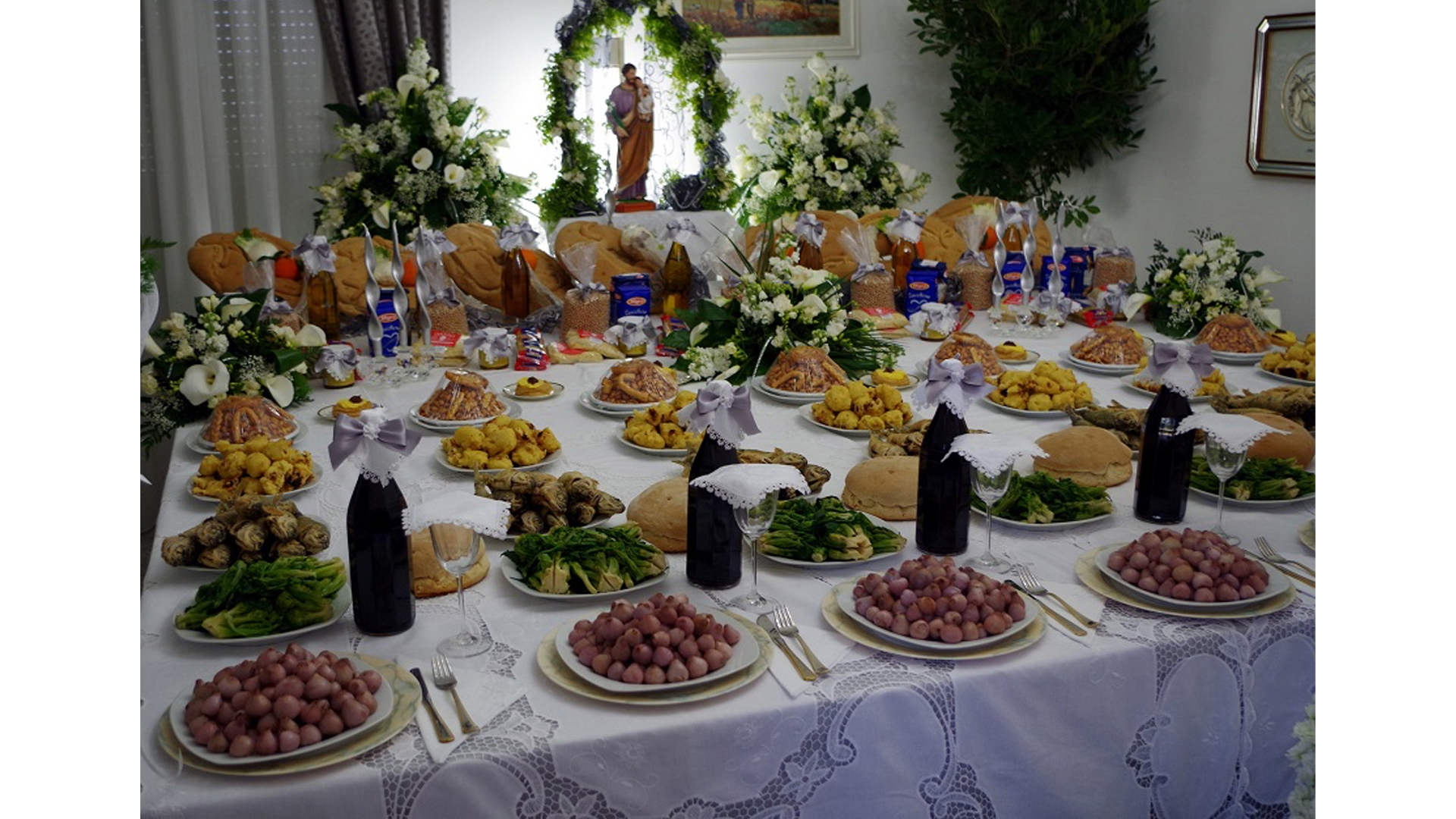The feast of St. Joseph, known in Italian as la Festa di San Giuseppe, is the Catholic celebration of Joseph, the husband of the Virgin Mary. The holiday is celebrated on March 19th each year, and often serves as the Italian Father's Day.
Food is central to the celebration of the feast. Since the Medieval era, celebrants have set up tavole di San Giuseppe, the table of San Giuseppe, in private homes. In public places like churches, altars to Joseph are created featuring statues of the saint, candles, flowers, and food.
The altars are decorated with symbolically significant food. Wheat bread loaves, baked into intricate shapes, are common. Seeds are sprinkled on the bread to represent new life, and baked into shapes like hammers, since Joseph was a carpenter, holy crosses, or animals to represent new life and bountiful harvests.
Breadcrumbs are often spread around, or included in the dishes. These represent sawdust alluding to the imagery of Joseph, the carpenter. Pasta made with breadcrumbs is traditionally served. When the feast concludes, the food from the tables and altars is gathered up and given to the poor.

(Photo Credit: NOLA)
Sweet Treats for St. Joseph
Joseph may be famous for his carpentry, but Italians believe he was also moonlighting as a baker. When Joseph, Mary, and their newborn baby were headed home from Jerusalem, Joseph supposedly worked as a baker selling various fried pastries to help with expenses. This work earned him the nickname frittellaro, meaning "pancake maker."
In Rome, the legend of Joseph the Pancake Maker is reason enough to eat bignè, a cream-filled puff pastry. In the north, choux pastry is filled with cream and known as tortelli di San Giuseppe. And what kind of holiday would it be without some zeppole? A Neapolitan baker in the 19th century invented a new type just for the holiday featuring a crispier dough. The baker, Pasquale Pintauro, topped his St. Joseph's Day zeppole with creamy custard and a candied cherry and they have since become a symbol of the holiday.
Sicilians also fry a fluffier dough known as Sfince di San Giuseppe. This fried pastry is topped with ricotta cream similar to a cannoli filling and topped with nuts and candied fruit.
Sweet filled ravioli also make appearances in some regions. In the south, the ravioli are made from traditional pasta dough, stuffed with a sweet filling, and fried. Originally these fillings were made from a mix of chickpea and walnuts, but now also include chocolate.
In Bologna, "ravioli" are made from shortcrust pastry. These cookies are folded over into a half-circle and filled with jam and preserved fruits known as mostarda. In the last century, St. Joseph's Day was seen as the end of the winter scarcity and the beginning of the spring abundance. The working class would celebrate by hanging these ravioli outside to help feed those less fortunate.

(Photo Credit: cucina.fidelityhouse.eu)
St. Joseph's Day In Sicily
Joseph is considered by many to be the Patron Saint of Sicily. Sicilians believe he saved their city from a medieval-era famine when a long drought left the city starving. Livestock was dying, crops were failing. The people prayed to St. Joseph.
Eventually, their prayers were answered. Rains arrived in Sicily leading to a bumper crop of fava beans that year. Ever since, Sicilians have made fava beans part of their St. Joseph Day celebrations. Favas feature prominently on the table and on the altars to St. Joseph. Dried beans are often blessed and considered a token of good fortune. But the beans are also eaten. They are added to frittatas and sauces, and in many places, fava beans are whipped into a paste or cream with onion and garlic – a bean dip similar to hummus.

(Photo Credit: siciliansecrets.it)
St. Joseph's Day In New Orleans
Although the United States is filled with Catholics, celebrating St. Joseph's feast is less common outside of Italian American communities. The Irish Catholics, for instance, are far more likely to spend the month of March celebrating St. Patrick. However, there is an exception in New Orleans.
In the Big Easy, the Sicilian enclave celebrates St. Joseph's Day as a major holiday. Sicilians are a big part of New Orleans culture, and actually began arriving in the city before the mass migration from Italy to other parts of the United States. Louisiana actively worked to attract Sicilians to New Orleans in the middle of the 19th century offering bounties and hoping they would serve as agricultural laborers. As a result of this immigration, a portion of the French Quarter is even known as "Little Palermo."
The Italian American St. Joseph Society, founded in 1970, helps keep the feast's traditions alive in the city. There is an annual St. Joseph's Day parade through the French Quarter, and numerous St. Joseph Day altars are installed around the city, keeping alive an Italian tradition. The bread, cakes, and cookies are often decorated like shellfish in New Orleans.
Other Siciliana traditions have found their way to the altars in NOLA too. Lemons and citrus fruits are included, and anyone stealing a lemon will end up finding a spouse. Olives are included too, recognizing the large oil industry in Sicily. Finally, they also serve Pasta di San Giuseppe, a vegetarian meal topped with breadcrumbs.
Ian MacAllen
Ian MacAllen is America Domani's Senior Correspondent and the author of Red Sauce: How Italian Food Became American. He is a writer, editor, and graphic designer living in Brooklyn. Connect with him at IanMacAllen.com or on Twitter @IanMacAllen.


